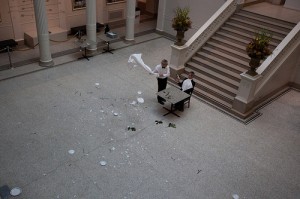Updated
Last night, Generic Art Solutions—Matt Vis and Tony Campbell—made a mess at NOMA. The Great Hall of the New Orleans Museum of Art hosted “Spill,” a performance art piece that featured Vis as a waiter inviting Campbell to sit at a table, then setting the table complete with a rose, then pulling the tablecloth off the table, sending the plates, glasses, silverware and flowers flying. Then they did it again and again, all accompanied by a pianist who played cocktail bar versions of everything from “You Are My Sunshine” to “Col. Bogey’s March.”
The performance was a preview of sorts for their upcoming show at NOMA, “Deja Vu All Over Again,” where repetition is a theme. In a talk before “Spill,” Contemporary Art Curator Miranda Lash showed slides of a few pieces from the show, photos and paintings that recreate earlier works in more modern contexts. “The point is not to recreate [the paintings] because we don’t live in the 19th Century,” she said, underscoring the relationship between art and its moment. “We live in the 21st Century.”
Her talk put “Spill” in the context of other repetitive action performance art pieces, many of which make themes of endurance and commitment—what are you willing to do for your art?—and how others approach a meditative quality through repetition. There was certainly a physical dimension to “Spill,” not only in the flying, crashing plates and glasses, but in the act of doing. There were a few iterations when Vis seemed to have tired from the effort of pulling the tablecloth. Because it was episodic, each iteration provided an occasion for further thought about the resonances of the performance: Vis and Campbell’s black and white attire linked to the notion of “generic,” both as a color scheme and as typical waiter and diner in a fine dining establishment; the tension between the formality of the venue and the chaos of the crashes; the subtle, accidental differences in each iteration as Vis occasionally started to act out of sequence, or the differences in cloth-pulls and the resulting crashes; and the context, as Vis and Campbell created this performance in a room of black and white works by the late New Orleans artist John Scott.
In her talk, Lash also introduced the thought that there is a political dimension to “Deja Vu All Over Again” as people seem to respond to crisis over and over again in the same way and get the same results. With that seed planted, it was also impossible not to consider “Spill” from a political perspective and watch the same actions play out again and again and again, each time with the same catastrophic results, even when minor variations occurred in the process.
The only missed opportunity was likely a function of liability concerns. Viewers were asked to stand upstairs on the balcony overlooking the Great Hall. They were safe there, but that level of remove separated them from the work and its consequences. I was on the floor shooting video for a video package that I’ll post next week, and I had a bowl skitter by me and was hit with chips of a plate or bowl. NOMA asked me to wear goggles, but that level of physical involvement kept the piece from ever seeming slow and literalized the political dimension as the repeated actions between two parties had an effect on a remote, uninvolved third party, and how their actions caused anxiety—or heightened awareness, really—that the third party could be affected again.
The intelligence of “Spill” and its slapstick nature—it was, after all, a physical comedy trope that has played out in movies for decades – bode well for “Deja Vu All Over Again,” and it worked beautifully as a stand-alone piece.
For more photos of “Spill” by Joshua Brasted, see his flickr feed.
Updated October 14, 10:49 a.m.
Joshua Brasted’s photo was added, as was the link to his photos.





